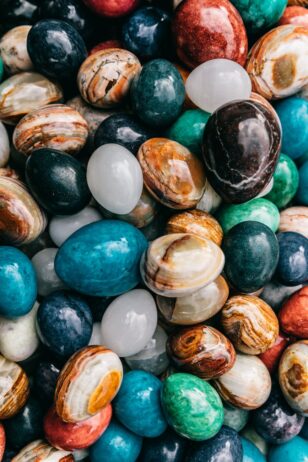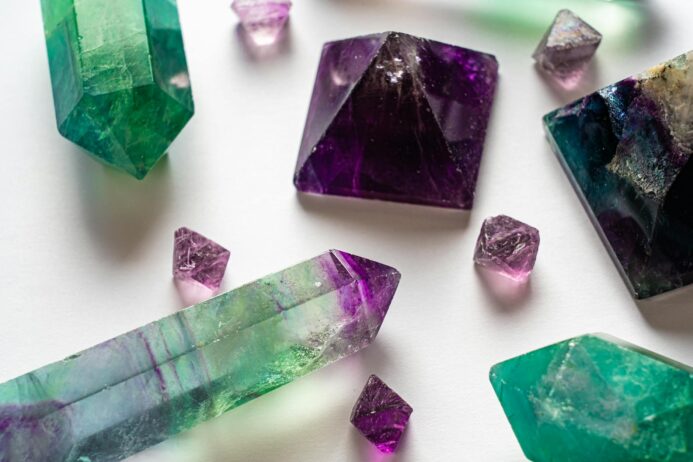Introduction: Unveiling the Mystique of Obsidian
Obsidian is a naturally occurring volcanic glass, formed when lava cools so rapidly that the minerals within do not have time to crystallize. For millennia, civilizations have marveled at its sleek, glassy appearance, using it for everything from sharp tools to decorative jewelry and even spiritual healing. Today, obsidian remains a prized gemstone not only for its aesthetic qualities but also for its rich history and metaphysical properties.
In this comprehensive guide, we dive deep into the types of obsidian that adorn museums and jewelry boxes alike. We will explore intriguing varieties such as Apache Tears and Snowflake obsidian, decode the meaning behind these fascinating stones, and discuss the science that governs their formation. Whether you are a gemstone enthusiast or simply curious about volcanic glass, read on to discover how obsidian can captivate your imagination and style.
The Formation and Science of Obsidian
How Obsidian is Formed
Obsidian is born from the fiery depths of the earth. When siliceous lava is ejected from a volcano and cools rapidly, it solidifies into a glass-like material with minimal crystal formation. The result is a smooth, uniform texture that can range in color from jet black to dark green, brown, and even multicolored variations.
- Rapid Cooling: The key to obsidian’s glassy texture is the rapid cooling of lava, which prevents crystal growth.
- High Silica Content: Its high silica content gives obsidian its characteristic smoothness and reflective quality.
- Natural Variations: The impurities and trace elements present during formation lead to the variety of obsidian types we see today.
Physical and Metaphysical Properties
Obsidian is celebrated for both its physical attributes and its metaphysical significance. In jewelry, its sharp edges and glossy finish create a modern, edgy look. Spiritually, obsidian is believed to offer protection, grounding, and insight, helping its wearer to confront inner truths and release negativity.
- Durability: While being a glass, obsidian can be surprisingly durable, though care must be taken to avoid chipping.
- Reflective Quality: Its smooth surface reflects light and is often associated with clarity and introspection.
- Emotional Healing: Many metaphysical practitioners believe obsidian can absorb negative energy and promote emotional healing.
Exploring Obsidian Varieties
Classic Obsidian
Classic obsidian is usually jet black, with a uniform, mirror-like surface. It has been used historically for making cutting tools and mirrors, as well as jewelry. This type of obsidian is simple yet striking, perfect for those who appreciate understated elegance.
Apache Tears
Apache Tears are a unique type of obsidian, characterized by their translucent quality and rounded, tear-drop shape. Despite their delicate appearance, these stones are surprisingly tough. The term “Apache Tears” is steeped in Native American legend, with stories often describing them as the tears of the Apache people during times of hardship. Symbolically, Apache Tears are believed to bring comfort during sorrow and act as a protective talisman.
- Meaning: Healing, protection, and emotional release.
- Appearance: Typically dark, sometimes with a translucent quality when held up to light.
- Uses: Popular in pendants, beads, and small carvings.
Snowflake Obsidian
Snowflake obsidian is notable for its striking white or gray crystalline inclusions that appear like snowflakes against a dark background. These inclusions are actually tiny crystals of cristobalite. The contrast creates a beautiful, frosted look that makes this variety stand out in any collection.
- Meaning: Balance and clarity; the snowflakes are often seen as symbols of transformation and new beginnings.
- Appearance: Dark base with white specks or patterns resembling snowflakes.
- Uses: Ideal for statement jewelry such as rings and pendants, as well as for metaphysical practices aimed at grounding and clarity.
Rainbow Obsidian
Rainbow obsidian displays iridescent colors when viewed from different angles, often shifting between greens, blues, and purples. This variety is less common but highly coveted for its vibrant and almost otherworldly appearance. It is created when microscopic inclusions in the obsidian scatter light in multiple wavelengths.
- Meaning: Creativity, transformation, and a connection to nature’s myriad colors.
- Appearance: Multicolored sheen with a dynamic, shifting pattern.
- Uses: Often used in artisan jewelry, these pieces serve as unique statement items.
Mahogany Obsidian
Mahogany obsidian features reddish-brown or mahogany streaks throughout its dark, glossy body. The interplay of red and black tones gives it a warm, earthy look that resonates with those who seek both strength and passion in their jewelry.
- Meaning: Grounding energy, emotional balance, and passion.
- Appearance: Rich reddish-brown streaks against a dark base.
- Uses: Frequently used in carved pieces and cabochons for jewelry designs.
Comparing Obsidian Varieties: A Quick Reference
| Variety | Appearance | Key Meanings | Common Uses |
|---|---|---|---|
| Classic Obsidian | Jet black, mirror-like | Protection, clarity | Jewelry, tools, mirrors |
| Apache Tears | Translucent, tear-drop shape | Healing, comfort, protection | Pendants, beads, talismans |
| Snowflake Obsidian | Dark base with white inclusions | Balance, clarity, transformation | Rings, pendants, statement jewelry |
| Rainbow Obsidian | Iridescent, multicolored sheen | Creativity, transformation | Artisan jewelry, statement pieces |
| Mahogany Obsidian | Dark with reddish-brown streaks | Emotional balance, passion | Carvings, cabochons, jewelry accents |
Cultural and Historical Significance
Ancient Uses and Symbolism
Obsidian has been revered by many ancient cultures, not only for its beauty but also for its symbolic power. It was used in Mesoamerican cultures for ceremonial blades, mirrors, and ornaments due to its sharp edges and reflective quality. In Native American traditions, obsidian was often regarded as a stone of protection and a tool for divination.
- Protection: Many cultures believed that obsidian could ward off negative energies and evil spirits.
- Divination and Healing: Obsidian was used in scrying and healing rituals to reveal hidden truths and cleanse emotional wounds.
- Tool Making: Its natural sharpness made obsidian an essential material for creating cutting tools and weapons.
Modern Interpretations
Today, obsidian is celebrated not only as a beautiful gemstone but also as a symbol of transformation. Whether used in jewelry or as a metaphysical tool, its energy is believed to help individuals confront inner darkness and emerge stronger.
- Apache Tears: Often worn as a reminder of overcoming grief and hardship.
- Snowflake Obsidian: Valued for its ability to bring clarity and balance in times of change.
- Rainbow Obsidian: Embraced by creative souls for its vibrant, dynamic energy.
Practical Tips for Incorporating Obsidian in Jewelry
Care and Maintenance
Obsidian, being a natural volcanic glass, requires a bit of extra care to maintain its luster and prevent scratches:
- Cleaning: Use a soft cloth and mild soap with warm water. Avoid harsh chemicals and abrasive cleaners.
- Storage: Store obsidian jewelry in a padded case or a soft pouch to prevent scratches.
- Handling: While obsidian is durable, it can be brittle. Handle your pieces with care, especially if they are carved or intricately designed.
Checklist: Selecting the Right Obsidian Jewelry
- ✔ Identify the variety of obsidian you prefer (e.g., Apache Tears, Snowflake, Mahogany, etc.).
- ✔ Consider the symbolism and meaning behind each variety.
- ✔ Ensure the piece is well-crafted and suited for your lifestyle.
- ✔ Check for proper care instructions to maintain its shine.
- ✔ Choose a design that resonates with your personal style and intentions.
Case Study: A Journey with Apache Tears
Meet Sarah, an avid jewelry collector and spiritual seeker. After experiencing a period of personal loss, Sarah was drawn to Apache Tears for their reputed healing properties and protective energy. She chose a handcrafted pendant made of Apache Tears and incorporated it into her daily meditation practice. Over time, she noticed that the pendant not only served as a beautiful accessory but also became a talisman of strength and comfort during challenging times.
- Design: The pendant featured a polished, tear-drop shape that showcased the unique translucency of Apache Tears.
- Symbolism: For Sarah, Apache Tears symbolized emotional release and resilience.
- Impact: Wearing the pendant daily helped her embrace healing and gradually transform her perspective on loss.
Further Reading and Internal Resources
For those interested in exploring more about gemstone science and obsidian’s rich history, check out our internal guides:
- Gemstone Lore & Science – Dive deeper into the stories and science behind your favorite gems.
- Jewelry Education & Buying Guides – Expert tips on selecting quality jewelry pieces that resonate with your style.
- Vintage & Antique Jewelry – Explore timeless pieces that reflect a rich cultural heritage.
Conclusion: Embrace the Power of Obsidian
Obsidian is a captivating gemstone that offers much more than its striking appearance. From the healing symbolism of Apache Tears to the balanced clarity of Snowflake obsidian, each variety has its unique story to tell. Whether you’re drawn to the spiritual properties, the stunning visual appeal, or the rich historical context, obsidian can add a profound dimension to your jewelry collection.
“Obsidian teaches us that beauty often emerges from the raw and unrefined. Embrace its mysteries and let its transformative energy guide you through life’s darkest moments.” – Gemstone Science Expert
By understanding the various types of obsidian and their meanings, you can make more informed choices when adding these unique pieces to your collection. Let obsidian’s ancient allure and modern sophistication inspire you to explore a world where gemstone science and personal expression meet in perfect harmony.


